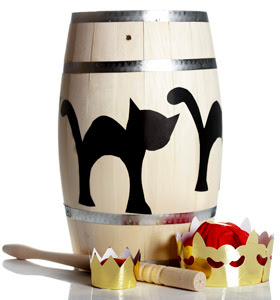Fastelavn is the name for Carnival in Denmark which is the either Sunday or Monday before Ash Wednesday. Fastelavn evolved from the Roman Catholic tradition of celebrating in the days before Lent, but after Denmark became a Protestantnation, the holiday became less specifically religious. This holiday occurs seven weeks before Easter Sunday and is sometimes described as a Nordic Halloween, with children dressing up in costumes and gathering treats for the Fastelavn feast. The holiday is generally considered to be a time for children's fun and family games.
Some towns in Denmark are renowned for their large Fastelavn festivities and parades. Traditional events include slå katten af tønden ("hit the cat out of the barrel"), which is somewhat similar to using a piñata. The Danes use a wooden barrel, which is full of candy and oranges and has the image of a cat on it. Historically there was a real black cat in the barrel, and beating the barrel was superstitiously considered a safeguard against evil. After the candy pours out, the game continues until the entire barrel is broken. The one who knocks down the bottom of the barrel (making all the candy spill out) becomes kattedronning ("queen of cats"); the one who knocks down the last piece of the barrel becomes kattekonge ("king of cats").
There seem to be some small local traditions which are closer to the carnival traditions of other countries, including Ash Wednesday, Carnival parades, Pancake Tuesday and eating special food after Ash Wednesday, but they are not particular to Danish culture.In Denmark and Norway a popular baked good associated with the day is Fastelavnsbolle (lit. "Fastelavns bun", also known in English as "shrovetide bun" or "lenten bun"), a round sweet roll usually covered with icing and sometimes filled with whipped cream. Similar buns are eaten in other northern European countries, for example the Swedish Semla. Ísafjörður is the only town in Iceland that celebratesFastelavn on the same day as the Nordic countries, the day being known as Maskadagur (from the Danish word maske, meaning to dress-up or put on a mask).
Another popular custom (especially among the children) is the "fastelavnsris", with which children ritually flog their parents to wake them up on the morning of Fastelavns Sunday (Quinquagesima).
Fastelavnsris have many shapes and forms and differ from area to area. In some areas they are bunches of twigs, usually from fruit trees and preferably with buds. Those are often decorated with feathers, egg-shells, storks and little figures of babies. In other areas, they are a bent willow-branch, shaped like an ankh and wound with crepe paper that has frizzles cut with scissors. Both varieties may be decorated with candy as well.
The custom is known already in the 18th century in Denmark and it has several roots. There is probably no doubt the custom originates from an old fertility ritual, which has been absorbed into Christianity. The more serious one is that after the reformation, particularly pious people used to flog their children on Good Friday to remind them of the sufferings of Christ on the cross. A similar custom is mentioned in the book "Frauenzimmerlexicon", published in 1715 in Leipzig (Germany), which describes how bachelors and virgins "bid each other goodmorning" by flogging each other and spreading ashes on each other. This custom is also known in Denmark.
Earlier, it was mainly the young women and the infertile who were flogged. It was also common that a young man would carry his "fastelavnsris" and (of course gently) strike at young women he met on the street. Later it became the children's special right to flog their parents on this day. In any case, the reward given for the flogging would be a fastelavnsbolle.

.jpeg)


No comments:
Post a Comment